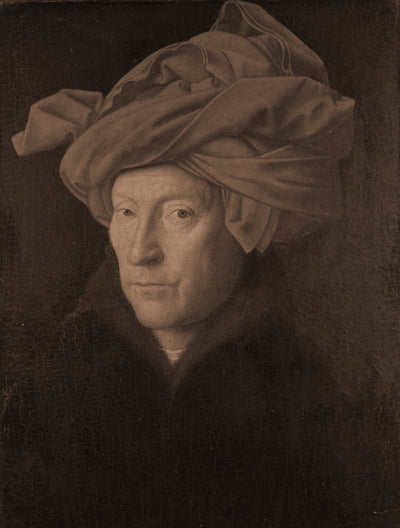Jan van Eyck
| Nombre de nacimiento: | Johannes de Eyck. |
|---|---|
| Nacionalidad: | Flamenca. |
| Nacimiento: | 1390, Maaseik, Flandes. |
| Muerte: | 1441, Brujas, Flandes. |
| Estilo: | Flamenco, renacentista. |
La imagen del artista mostrada aquí es posiblemente un autorretrato, no existe actualmente una imagen confirmada al 100% del pintor.
Iniciador de la pintura flamenca, y considerado como pionero el nórdico del primer Renacimiento.
Jan van Eyck junto al Maestro de Flemalle (Robert Campin) y Rogier van Weyden, fueron los artistas más célebres de esta escuela, y los más virtuosos en el empleo del óleo.
Nació hacia el año 1390 y trabajó en 1425 para Felipe el Bueno como pintor de cámara y hombre de confianza. Este status le concedió el beneficio de su respetable reputación dándole una gran libertad artística. En 1432 van Eyck se instala en Brujas donde muere años más tarde.
Su obra se destaca especialmente por su minuciosidad, característica que lleva a deducir su carácter observador y detallista. También se le admira por la carga psicológica que conllevan sus obras, llenas de vitalidad.
Sus trabajos se componen fundamentalmente de retratos y escenas sacras, generalmente marianas. Antiguamente se le atribuía el mérito de la introducción del óleo, aunque no se sabe muy bien, ya que otros contemporáneos la usan también, pero es Jan van Eyck quien la lleva la técnica a sus cotas más altas.
Su primera tabla conocida es firmada junto su hermano Hurbert van Eyck, quien la empieza y es Jan quien la acaba tras su muerte. Esta obra llamada Políptico del Cordero está compuesta de 12 tablas de las cuales 8 están pintadas también por detrás para verlas cuando se cierra el políptico. A esta obra se le considera la primera con plena madurez pictórica del estilo flamenco.
-

"Políptico del Cordero", (Hermanos Van Eyck).
En la tabla central aparece el tema de la Adoración al Cordero Místico. En esta escena se representa a Cristo como un cordero triunfante y sacrificado, adorado por sus fieles. Van Eyck destaca el sol, el cordero y la fuente de vida. La imagen central se flanquea a izquierda y derecha por otras cuatro que representan los caballeros, jueces, ermitaños y peregrinos de Cristo. En la parte superior está representado Dios, con San Juan Bautista y la Virgen. En los extremos están Adán y Eva y en medio hay sequitos de ángeles cantores celebrando el triunfo de Cristo.
Uno de los retratos más famoso de Jan van Eyck es El Hombre con Turbante Rojo, de 1433. Aunque no se sabe muy bien quien es el hombre se ha pensado que podría ser su suegro o un autorretrato. La expresión apretada de los labios y la tez pálida constituyen una muestra formidable de la maestría del estilo flamenco. El turbante rojo tiene especial importancia ya que contrasta a la vez con la piel blanca y el fondo oscuro. Este cuadro lleva inscrito el lema típico flamenco “Como puedo” que se interpreta como una frase modesta (lo hago lo mejor que puedo).
-

"El Hombre con Turbante Rojo", (1433).
Sin duda el Retrato más famoso es El Matrimonio Arnolfini, 1434.
En este retrato encontramos al rico mercader italiano Giovanni Arnolfini, con su esposa en el interior de la alcoba. Se cree que este representa la boda del mercader ya que en el s. XV se podían contraer matrimonio sin sacerdote, en la intimidad de una casa.
-

"El Matrimonio Arnolfini", (1434).
Los elementos de la tabla son simbólicos, como en toda pintura flamenca, donde no hay nada que no tenga un sentido definitivo.
Arnolfini coge a su mujer con la mano izquierda y levanta la derecha como señal de promesa mientras que la mujer sitúa su mano izquierda sobre el vientre, como señal de sumisión, a su vez su ropa es verde, que resembla esperanza. Detrás se encuentra un cirio encendido haciendo alusión al sacramento y hay una estatua tallada de santa margarita, la patrona del parto. Los zuecos hacen referencia a lo sacro y la fruta junto a la ventana es señal de fertilidad. El perro simboliza la fidelidad de los esposos.
También vemos el espejo detrás de los novios donde se revela el pintor y otros dos testigos. Van Eyck firma con la inscripción “Van Eyck estaba aquí.”
Por último, entre las obras de temática religiosa destaca la siguiente.
-

"El La Virgen del canciller Rolin".
Esta pintura es muy interesante ya que refleja la fuerte desacralización que la pintura flamenca propuso ya que se ve una coexistencia entre los santos y los vivos. Como vemos Rolin y la Virgen María, no tienen ninguna distinción de tamaño, como se hacía hasta esa fecha por orden de importancia, y no hay nada que les separe. Podemos observar la maestría de Jan van Eyck ya que pinta las texturas de la ropa y las lejanías (en la ventana posterior) de una manera formidable.
¿Quiere un cuadro al óleo inspirado en Jan van Eyck, en su casa?
Encárguelo en la sección de cuadros al óleo personalizados
Pintores famosos relacionados:
